Mushrooms, ignored by many, have turned out to be one of the most important keys to humans’, animals’ and planet Earth’s health.
Just like trees and many other plants cannot grow without the presence of fungi, we also benefit from eating it.
Mushrooms are very low in calories, full of nutrients, and high in proteins and fiber. They also boost our immune system, help to fight cancer, and have anti-inflammatory powers. Scientists believe that they also help fight aging.
There are many different types of mushrooms, some of which are edible, like oysters, lion mane, porcini, button, shiitake, and many more. There are also many species that are not edible at all and can cause stomach pain if eaten and, in some cases, could even be fatal.
But the best news about mushrooms is that they can be eaten by everyone: meat lovers, vegetarians, and flexitarians. They can be used as a main or side dish, be dried as a snack, or blended to make a soup, and you can even make mushroom tacos.
Autumn is the best time to start foraging for fungi in the woods. But what do you do if you want fresh mushrooms all year round or it’s forbidden to pick them at all? Or what if they are not native to where you live and are very expensive?
Why not try something different and start growing your own mushrooms at home?
So, I decided to give it a try and started growing mushrooms at home. I love oysters, buttons, and shiitake mushrooms, and those are very easy to grow. I did some research and bought some liquid culture online. (It’s available to buy from around the world.)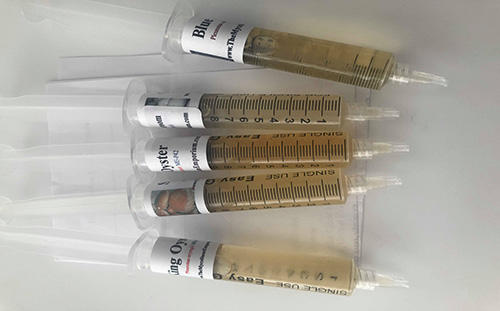 Related: Harvesting and Using Dandelion Roots – The Natural Detoxifier
Related: Harvesting and Using Dandelion Roots – The Natural Detoxifier
While I was waiting for my delivery, I made some preparations:
#1. I bought some one-liter Mason jars.
Some people use plastic bags instead for this part, but I don’t want any wastage, and those jars can be reused countless times.
I also bought 4 kg of millet grain as it was the cheapest option for me, but you can use any grain, even popcorn.
#2. You can put millet in a bucket with a lid or in any other pot you have.
Then pour boiling water over it, cover the bucket, and let it soak for 24 hours. Then drain the millet and fill the jars two-thirds to three-fourths full.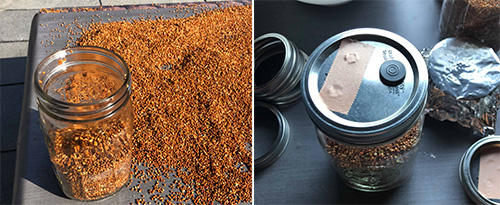 #3. I drilled three holes on the lids: one hole covered with a rubber stopper (so I could use it to inject the liquid culture without opening the lid) and two holes covered with medical tape for ventilation.
#3. I drilled three holes on the lids: one hole covered with a rubber stopper (so I could use it to inject the liquid culture without opening the lid) and two holes covered with medical tape for ventilation.
#4. Then I put the foil on top of the lids and put it in a pressure cooker for an hour to kill any bacteria.
I let it cool in the pressure cooker.
Mushroom liquid cultures arrive in a syringe, so it is very easy to inject it into the prepared jars.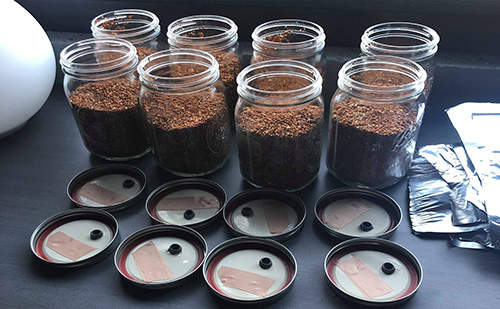
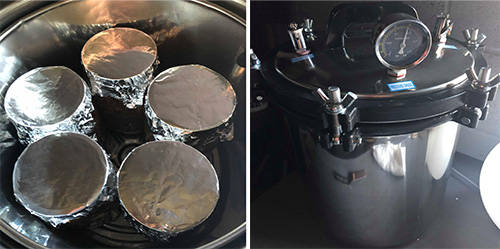 #5. Heat the needle on your spore syringe until it becomes red, and allow it to cool. This kills all of the germs.
#5. Heat the needle on your spore syringe until it becomes red, and allow it to cool. This kills all of the germs.
#6. Inject up to 2 ml of the solution into your jar via the rubber port.
You will need one syringe for every five jars.
#7. Store it in a dark, warm place for two to three weeks.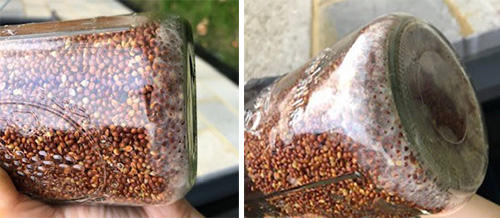 Do not open the lid during this time. When the jar becomes full of mycelium (white fluffy stuff), it’s time to transfer it to the straw bags.
Do not open the lid during this time. When the jar becomes full of mycelium (white fluffy stuff), it’s time to transfer it to the straw bags.
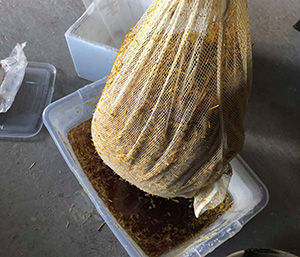
#8. I took some chopped straw and soaked it in water with some hydrated lime for 24 hours.
The lime drastically increases the pH of the water and automatically kills bacteria, mold spores and, other contaminants.
#9. Once drained, the straw is mixed with mushroom spawns from your jar (one jar for one plastic bag of a straw) and stored in the plastic bags with some ventilation in a dark, warm place for another two to three weeks.
Related: Straw-bale Bug Out House: How One Of Our Readers Did It
#10. Your bags are ready to fruit when they become white again.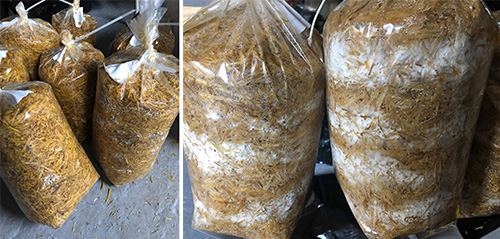 Sometimes you can see little mushrooms bursting to life.
Sometimes you can see little mushrooms bursting to life.
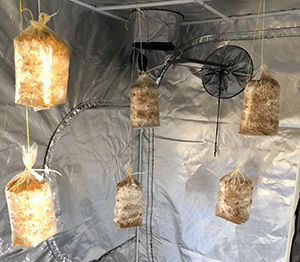 #11. Cut small holes two to three inches apart, and hang your bags in a humid greenhouse. (If you don’t have a greenhouse, just place the bag in the bowl and spray it with water three times a day to keep it moist.)
#11. Cut small holes two to three inches apart, and hang your bags in a humid greenhouse. (If you don’t have a greenhouse, just place the bag in the bowl and spray it with water three times a day to keep it moist.)
Your bags are ready to fruit, and they no longer need to be kept warm.
This is the best time. Each day you will find your mushrooms growing larger and larger.
When the edges of the caps begin to turn upward, it’s time to harvest them and eat or store them in a dry and cool place.
Usually, it takes three to four days for mushrooms to grow, so don’t forget about them. 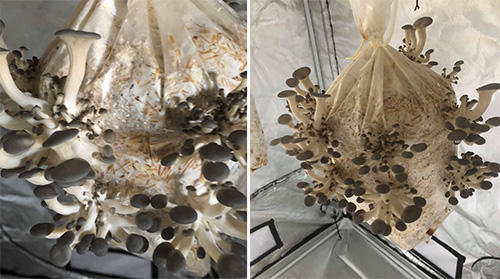 Just twist or cut the stem from the bag, and get cooking.
Just twist or cut the stem from the bag, and get cooking.
Mushrooms are a superfood and one of the most health-promoting foods on our planet.
You may also like:
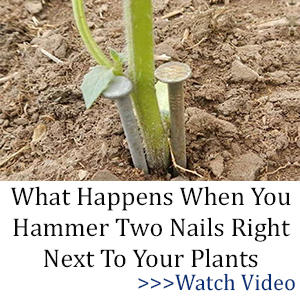 Amaranth Superfood- Storing And Using It For Survival
Amaranth Superfood- Storing And Using It For Survival
Cheap and Easy to Build Root Cellar in Your Own Back Yard (Video)
5 Survival Foods Your Grandmother Used To Make

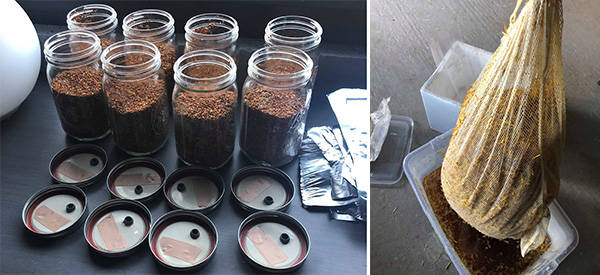













Do you need a grow light
Hi Mike – No, you don’t need a grow-light. The lesser amount of light over a few weeks time the better. Also be sure, as the author states, to keep the environment warm, during this period.
It’s great doing it that way if you have limited space, but I think you would get a whole lot MORE mushrooms if you spread out that sawdust instead of only getting what comes thru the holes.
That is a lot of work considering that commercial Mushroom growers just use trays stacked so far apart in caves. I do not think they use grow lights. It has been a while since I watched that special on TV.
Commercial growers use long beds stacked about a foot apart in large grow rooms. They are grown on composted horse manure that is steamed to kill bacteria and then spores are spread over the top and the whole bed is covered with black plastic until they begin to sprout. Then the entire bed is covered with peat moss about 2 inches deep and the mushrooms are left to grow about a week until they are ready to pick. Pickers enter the dark rooms and wear miners lights to pick the shrooms for about a week, and then the whole room is “cooked off” with steam again to kill everything in the room before the beds are emptied and the process starts all over again.
For the record, I worked on a mushroom farm for awhile 20 plus years ago. Very hard work, and everything has to be kept sterile while the shrooms are growing so there is no accidental bacteria added that will grow non desirable fungi.
Unless one already has the required equipment on hand, it seems like a lot of expense and work for growing an item, that while it has nutrients in it, furnishes almost zero calories. The result of this activity results in minus calories which is a big plus if one is trying to lose weight and fat but in an EOTW situation, body fat and caloric intake is going to be of prime importance because we will, like our grandparents and great grandparents, be expending considerable calories just trying to obtain those crucial calories.
The days of being able to drive to the fast food outlet in the car, expending very few calories and being able to get a day’s worth of caloric intake (not talking about the healthfulness, just merely caloric intake) in exchange for us engaging in remunerative activity for perhaps fifteen minutes or less, depending on the rate of pay, and that remunerative activity requiring the expenditure of scant calories above normal resting caloric expenditure. Those days will be a distant memory. Even assuming that we have adequate stores of food on hand, gathering and preparing wood for the food preparation and heating of our shelter will keep us slim and trim.
It is an interesting hobby activity, but I don’t see it as a successful endeavor for survival.
You’re right about mushrooms being pretty poor on the calorie front. They are high in protein though, and that could make them useful. They’re definitely not going to replace a good garden, but if you have them established in your basement I can see times that would be handy. Say there was an extreme weather event or nuclear accident, and you had to shelter in the basement for an extended time. You can’t get out to hunt, so a ready supply of fresh mushroom protein would be nice to have.
I am wondering what minimum temperature is considered “warm.”
2 books I’d recommend on this subject are Organic Mushroom Farming & Mycoremediation by Tradd Cotter and Growing Gourmet & Medicinal Mushrooms by Paul Stamets. I have probably mentioned them before on another post but they have been the best information I’ve found.
Mushrooms grown as the article mentions are not your button, field or portabello style which are secondary composers. These are the wood lovers like Oysters (straw), enoki, lions mane, shiitake, reishi, turkey tail (sawdust/logs)
While low in calories they are high in photochemicals and add flavour and other nutrients which are good for us. And they usually do better in a well lit room. In cooler area they can be grown outside but they can’t dry out, hence only cutting small eruption holes in the bags for mushrooms to emerge.
For anyone with a bit of garden space the process can be done on wood chips on your paths with king stropharia or blewits.
If it wasn’t so hot here I’d try the garden method but yesterday was 42degC in the shade on the south side of the house! And it’s not yet full summer. I’ll have to stick with my bags of mushrooms in side.
According to my book by Tradd Cotter, 32-59degF, 0-15C. Then you choose the cold tolerant strains.
Interesting post, but I am not a fan of mushrooms…
So what is the start up cost on this project?
Things I had to buy:
Scalpel, isopropyl alcohol, Petri dishes, agar, king oyster mushroom (all for the tissue cultivation). I didn’t buy liquid culture but made my own cultures in a still air cabinet from a store bought mushroom.
Things I had on hand:
pressure cooker, canning jars, wheat, straw, plastic rubbish bags, foil.
Costs will differ from country to country so you’ll have to guesstimate that.
I downloaded some information and a great free book is one put out for third world regions called Mushroom Growers Handbook which can be downloaded from archive.org
Hope that helps some.
a scalpel may be hard but I have an extremely sharp, fairly short knife and somewhere in the “rejected” tool category I have pieces of an xacto knife I need to collect in one container and donate.
i’m in a two bedroom apartment so I don’t have the space to fill a whole plastic rubbish bag with mushrooms (unless someone puts together a lab at the local community garden).
I think i’ll have to remind mom she promised to split the cost of a pressure cooker and a dehydrator with me. we live up the street from each other so we swap ingredients and kitchen tools all the time.
Just remember some of us who come to these sites aren’t Preppers but want to learn something useful. 😉
Because I have little space and a tight budget I need to miniaturize and streamline this process. I have a pot suitable for bath canning and a steamer that fits inside it that I can use for sterilizing. So… how small and cheap can you make this process?
I also have questions about what sorts of substitutes can be used in mushroom farming and whether the presence of earthworms will negatively impact mycelia growing in my compost.
My guinea pig, who provided manure for my garden, recently passed and I have a whole bag of aspen chips and alfalfa pellets left behind. Pounds of the latter in fact. can I use either of these? Will some wood loving mushrooms colonize steamed oak twigs in a canning jar? (Lion’s mane) and even though I have active mycelial growth, my current attempt stinks! is it still viable? is the mycelium unhealthy?
what are some low tech ways to get mushrooms from the store to take on household junk like cardboard or brown paper?
There are different mushrooms for different substrates. Portobello and button types grow in the dark on compost usually in trays or beds, oysters on the other hand grow on straw in plastic bags and others like shiitake grow on logs.
Get that book from archive.org and it will show you the low tech way of growing. There’s a section on tissue culture iirc which is when I used the scalpel . I didn’t learn this because I’m a preppier but because I love gardening and it was a way of gardening indoors plus I’ve now got some varieties growing outside in the veggie garden where the waste is used.
As for the white rice I’m not sure.
thanks for recommending the books, I’ll bookmark that page in general then poke paul stamets’ book with a stick. 😀 i liked his story about working on the Agarikon mushroom and how it made the DOD start cursing in shock! XD If you don’t have it I reccomend “Lasagna Gardening” by Patricia Lanza and “Carrots Love Tomatoes” forgot who wrote that. The first is a low effort way to set up a garden bed the second is about boosting your plants strength and yield with companion planting.
i used to rent the other bedroom in my apartment out… >.> extra cash figured what could go wrong. well the only roomie i had that didn’t cause a problem was mom. so that room is now my personal plant tinkering room. :E though I put some comfy rugs down so I could share it with my cat. i have a couple of 3 foot avocado trees around as many years old, maybe a bit more, a coffee tree around the same age and a lovely lemon tree about a foot tall that I’m trying to wrestle into a rough espalier so i can put it outside in the summer against the brick wall of my building. I’ve also started forcing Hyacinth bulbs indoors in the winter to help soothe me with their scent. The book i learned how to do this from is “Forcing Ecetera” forgot the author.
The way I see it every plant species I can take care of is like an entry in an artist’s portfolio. 😀 That said, Berkshire county winters are STUPID cold. oh sure global warming is giving us warm stretches, maybe 40 or 50 F tops for a few days, but the wind will rip the heat right out of you. I HAVE to go a bit bonkers with houseplants or I go insane!
The reason why I’m suspicious about the rice is because they do stuff to it while processing it that strips off the hulls and bran. So my guess is it might actually go faster than say wheat berries.
oh yeah forgot another question… is it possible to get mushroom spawn to take on white rice? wouldn’t it be really easy to access calories to them? I found a couple pounds like 5 years old. hate to waste them.